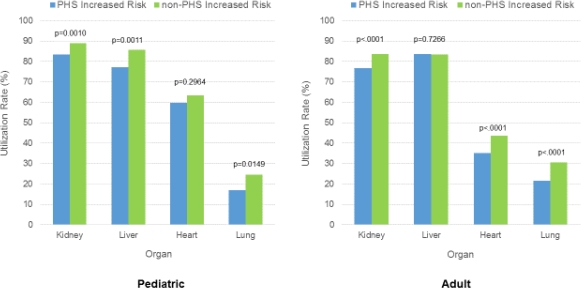The “PHS Increased Risk” Label Is Associated with Non-Utilization of Hundreds of Organs Per Year.
M. Volk,1 A. Wilk,2 C. Wolfe,3 D. Kaul.4
1Transplantation Institute, Loma Linda University, Loma Linda, CA
2United Network for Organ Sharing, Richmond, VA
3Division of Infectious Diseases, Duke University, Durham, NC
4Division of Infectious Diseases, University of Michigan, Ann Arbor, MI.
Meeting: 2016 American Transplant Congress
Abstract number: 23
Keywords: Donors, Informed consent, marginal
Session Information
Session Name: Concurrent Session: Donor Management: All Organs
Session Type: Concurrent Session
Date: Sunday, June 12, 2016
Session Time: 2:30pm-4:00pm
 Presentation Time: 3:06pm-3:18pm
Presentation Time: 3:06pm-3:18pm
Location: Room 306
The Public Health Service (PHS) guidelines use behavioral risk factors to designate certain organ donors as carrying increased risk for the transmission of hepatitis B, C, and HIV despite negative testing. OPTN policy requires that potential recipients be notified of this “increased risk” designation, although the magnitude of risk for disease transmission is approximately 1 in 1,000. We aimed to determine the impact of this label on organ utilization using OPTN data. Among adult donors (someone from whom at least one organ was procured for the purpose of transplantation) during 2010-2013, utilization rates were lower among PHS+ donors than PHS- donors for every organ except for liver (see figure). For example, 4,073/5,314 (76.7%) PHS+ kidneys were used, compared with 25,490/30,456 (83.7%) PHS- kidneys – an absolute difference of 7%. Furthermore, all PHS+ organs had higher export rates than PHS- organs. For example, 28.7% of PHS+ kidneys were exported, versus 19.7% of PHS- kidneys. Finally, the utilization rate of PHS+ organs varied by Donation Service Area. Utilization ranged from 20% to 100% among adult kidneys, suggesting significant variation in practices. Similar patterns were seen among pediatric donors.  In conclusion, the PHS “increased risk” label appears to be associated with non-utilization of hundreds of organs per year, despite the very low risk of disease transmission. Better tools are needed to communicate the magnitude of risk to patients and their families.
In conclusion, the PHS “increased risk” label appears to be associated with non-utilization of hundreds of organs per year, despite the very low risk of disease transmission. Better tools are needed to communicate the magnitude of risk to patients and their families.
CITATION INFORMATION: Volk M, Wilk A, Wolfe C, Kaul D. The “PHS Increased Risk” Label Is Associated with Non-Utilization of Hundreds of Organs Per Year. Am J Transplant. 2016;16 (suppl 3).
To cite this abstract in AMA style:
Volk M, Wilk A, Wolfe C, Kaul D. The “PHS Increased Risk” Label Is Associated with Non-Utilization of Hundreds of Organs Per Year. [abstract]. Am J Transplant. 2016; 16 (suppl 3). https://atcmeetingabstracts.com/abstract/the-phs-increased-risk-label-is-associated-with-non-utilization-of-hundreds-of-organs-per-year/. Accessed December 26, 2025.« Back to 2016 American Transplant Congress
